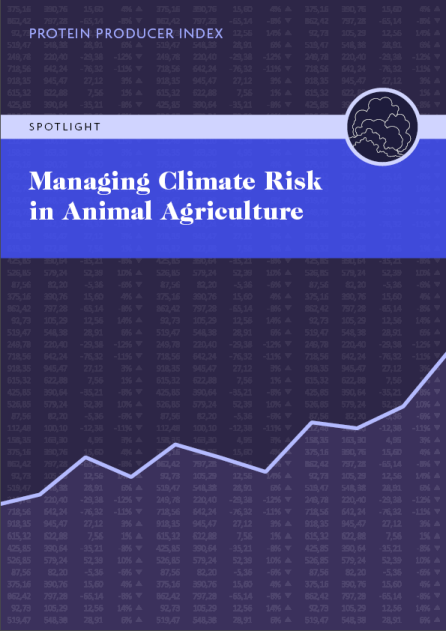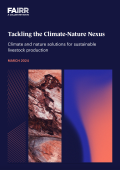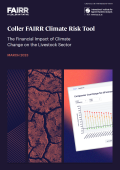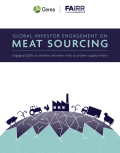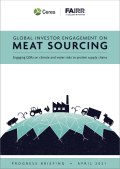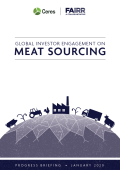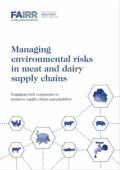Introduction
Protein producers are largely unprepared to meet the climate-related demands of their customers and incoming regulation. Poor disclosure of emissions and inadequate emissions reduction targets plague the sector; only 13% of companies have set science-based targets. Despite the material threats climate risks pose to protein producers’ market shares, cost bases and capital expenditures, only 18% of companies have conducted climate-related scenario analysis, and 7% discuss capital expenditure commitments to decarbonisation.
Animal agriculture is a key driver of global greenhouse gas emissions. The land sector, including agriculture, forestry and other land uses, is responsible for around 25% of net global greenhouse gas (GHG) emissions, and emissions from global livestock account for 14.5%. Of particular concern are methane and nitrous oxide emissions from the sector. Although short-lived in the atmosphere, these gases have 27 times and 273 times the global warming potential of CO2 emissions, respectively, over 100 years. Livestock is responsible for 44% of methane emissions and 53% of nitrous oxide emissions globally.
Growing concerns around these emissions, especially methane, have escalated this past year. The Sixth Assessment Report from the Intergovernmental Panel on Climate Change (IPCC) highlighted a 25% increase in emissions from enteric fermentation and manure since the nineties, primarily due to increased livestock numbers. This may be an undercount in regions like North America, where atmospheric measurements of GHGs next to animal production facilities are higher than official modelled estimates used by the Environmental Protection Agency (EPA).
Protein producers are, therefore, increasingly vulnerable to climate-related financial risks. As governments adopt net-zero targets, a key sectoral focus will be decarbonising animal agriculture like in New Zealand and the Republic of Ireland. New Zealand dairy producer Fonterra has stated given environmental restrictions, the country has reached ‘peak milk’, and Ireland is expected to have to cut its national cattle herd by 20% to meet its methane target. Added to this, in 2021, the US and EU and over 100 other countries pledged to cut methane by 30% by 2030 compared to 2020 levels.
Physical risks will exacerbate these transition-linked cost increases. In 2021, droughts in Brazil and the US contributed to inflation in feed commodity prices, which, in turn, increased meat prices – the Food and Agriculture Organisation (FAO) Meat Price Index increased by 20% between January and September 2021. The growing frequency of extreme weather events is already disrupting production. For example, in its third-quarter results, Tyson Foods reported that severe weather – including a deep freeze event in Texas – disrupted its beef and chicken production, offsetting increases in sales. In summer 2021, an unprecedented drought in North Dakota forced cattle farmers to sell their herds prematurely. These events will only continue to increase in severity and frequency.
Reporting Variations
Investors require consistent and comparable information to assess performance across companies and increasingly to calculate financed emissions in response to regulatory requirements. Disclosure on emissions performance in the listed animal protein sector remains inconsistent and incomplete. In particular, the sector underreports emissions linked to the most emission-intensive aspects of their business – animal farming, crop production and land-use change – which typically contributes more than 80% of total agricultural emissions.
Companies are not reporting sufficiently on emissions
In 2021, only nine Index companies (up from four in 2020) reported emissions from animal farming and feed for all geographies. The Greenhouse Gas Protocol is still developing guidance on how to account for and report all emissions from land-use change. This may explain why even these companies do not report emissions from land-use change, but this exclusion makes it difficult for investors to compare complete emissions performance and climate risk exposure.
Of the eight companies that reported inventories from animal farming and feed production in both 2020 and 2021, four reduced absolute emissions year-over-year. Salmones Camanchaca reports the largest decrease, 36%, primarily due to a decrease in Scope 3 emissions. But the company does not disclose what specific activities caused the reduction in emissions. Marfrig reports a 26% decrease in emissions from purchased goods and services and a 58.1% decrease in emissions from meat purchases., The largest increase was linked to SalMar, in part due to an increase of around 9% in feed purchases. Grieg Seafood’s reported emissions also increased significantly, primarily due to a change in the feed emission factors used for calculations.
Of those with incomplete inventories, 21 Index companies report a reduction in absolute emissions greater than 1.23% year-over-year, while 31% of companies report an increase in absolute emissions, compared to 32% in 2020. This indicates that even for companies targeting reductions on limited inventories, decarbonisation programmes are not working. Beef producer Minerva saw the largest emissions increase of 33%.
On an intensity basis, the aquaculture companies demonstrate a clear advantage over the beef and dairy producers – beef and dairy emission intensities are eight times and two times those of farmed fish, respectively.

